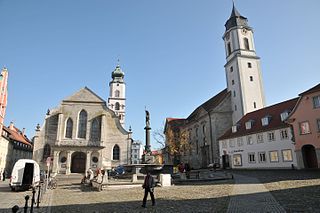
The Carthusians, also known as the Order of Carthusians, are a Latin enclosed religious order of the Catholic Church. The order was founded by Bruno of Cologne in 1084 and includes both monks and nuns. The order has its own rule, called the Statutes, and their life combines both eremitical and cenobitic monasticism. The motto of the Carthusians is Stat crux dum volvitur orbis, Latin for 'The Cross is steady while the world turns'. The Carthusians retain a unique form of liturgy known as the Carthusian Rite.

A choir, also sometimes called quire, is the area of a church or cathedral that provides seating for the clergy and church choir. It is in the western part of the chancel, between the nave and the sanctuary, which houses the altar and Church tabernacle. In larger medieval churches it contained choir-stalls, seating aligned with the side of the church, so at right-angles to the seating for the congregation in the nave. Smaller medieval churches may not have a choir in the architectural sense at all, and they are often lacking in churches built by all denominations after the Protestant Reformation, though the Gothic Revival revived them as a distinct feature.

Schussenried Abbey is a former Catholic monastery in Bad Schussenried, Baden-Württemberg, Germany. It is famed for its Baroque library hall. The abbey was established in the 12th century by the Premonstratensian Order and made an Imperial Abbey in the 15th century. The monastery sustained immense damage in the Thirty Years' War. In the 18th century, the abbey began expansions in the Baroque style, but was unable to complete them. The abbey was secularized in 1803 and twice awarded during the process of German Mediatization, eventually becoming a possession of the Kingdom of Württemberg. Its second king, William I, opened a foundry on its grounds, which was followed by a nursing home. These ceased operation or moved out of the monastery in the 1990s.

The Upper Swabian Baroque Route is a tourist theme route through Upper Swabia, following the themes of "nature, culture, baroque". The route has a length of about 500 km. It was established in 1966, being one of the first theme routes in Germany. There is an extension to the route into Switzerland and Austria around Lake Constance.
Ursberg Abbey is a former Premonstratensian monastery, now a convent of the Franciscan St. Joseph's Congregation, situated in the small village of Ursberg in the district of Günzburg, Bavaria.

Johann Baptist Zimmermann was a German painter and a prime stucco plasterer during the Baroque.

Lindau Abbey was a house of secular canonesses in Lindau on the Bodensee in Bavaria, Germany, which stands on an island in the lake.

Gaming Charterhouse is a former Carthusian monastery in Gaming near Scheibbs in the Mostviertel of Lower Austria.

Astheim Charterhouse, also known as Marienbrück Charterhouse, was a Carthusian monastery, or charterhouse, in Astheim near Volkach in Kitzingen, Bavaria, Germany.

Marienau Charterhouse is a Carthusian monastery, or charterhouse, the successor to the Maria Hain Charterhouse in Düsseldorf, located since 1964 in Marienau, a part of Bad Wurzach, district of Ravensburg in Baden-Württemberg. It is the only extant Carthusian monastery in Germany.

Cologne Charterhouse was a Carthusian monastery or charterhouse established in the Severinsviertel district, in the present Altstadt-Süd, of Cologne, Germany. Founded in 1334, the monastery developed into the largest charterhouse in Germany until it was forcibly dissolved in 1794 by the invading French Revolutionary troops. The building complex was then neglected until World War II, when it was mostly destroyed. The present building complex is very largely a post-war reconstruction. Since 1928, the Carthusian church, dedicated to Saint Barbara, has belonged to the Protestant congregation of Cologne.

Ignaz Waibl otherwise Ignatzius Woibl or Waibel was an Austrian woodcarver. His carvings are among the most significant of the period.

Güterstein Charterhouse was a Carthusian monastery in the Swabian Alb near Bad Urach, Baden-Württemberg, Germany.

Koblenz Charterhouse was a Carthusian monastery, or charterhouse, in Koblenz, Rhineland-Palatinate, Germany. It stood on the Beatusberg, a hill that forms the north-easterly tip of the Hunsrück overlooking the city. The site was first occupied by a Benedictine monastery, the Kloster St. Beatusberg, which was closed in 1315, when the monks were replaced by a community of Augustinian Canons until the Carthusians took over the site in 1331.

The Catholic parish church St. Ulrich is a Baroque church of the 18th century in Amendingen.

The Buxheim choir stalls are high baroque choir stalls created by Ignaz Waibl between 1687 and 1691 in the monastery church of St. Maria in Buxheim in Upper Swabia. Following the dissolution of the charterhouse in the course of secularization, it came into the possession of the count in 1803. Count Hugo Waldbott von Bassenheim had it auctioned off in Munich in 1883. When the chair came under the hammer again in 1886, the director of the Bank of England bought it at auction and donated it to the Sisters of St. Saviour's Hospital in London, England, who took it with them when the hospital was moved to Hythe in the county of Kent. When the hospital in Kent was dissolved, the choir stalls were bought back by the county of Swabia in 1980 for 450,000 pounds sterling, which is roughly equivalent to a price of 1.05 million euros. It was extensively restored between 1980 and 1994 and has since been returned to its original location in the former charterhouse in Buxheim.

Fürstenzell Abbey is a former Cistercian abbey in Fürstenzell, in Bavaria, in the diocese of Passau. It was a daughter monastery of the Aldersbach monastery from the filiation of the Morimond primary abbey - Ebrach monastery.




















